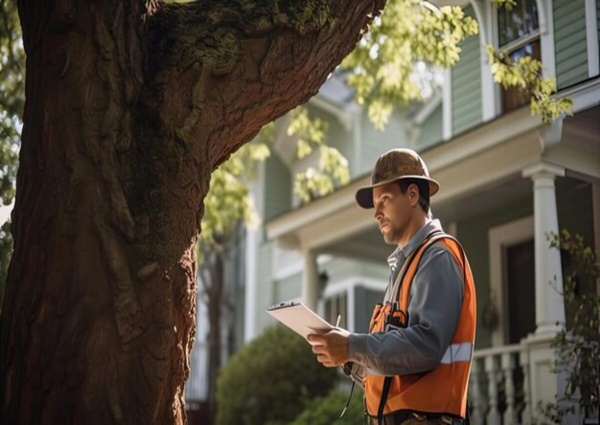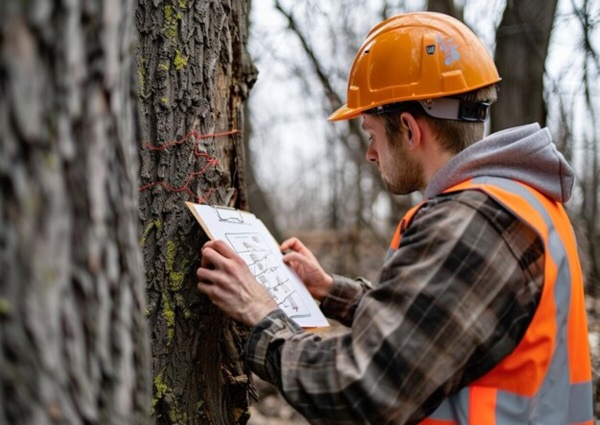Tree care plays a vital role in keeping your property safe and well-maintained. Here’s why regular tree inspections should be a top priority for every property owner.
Trees not only offer shade, enhance air quality, and boost property value, but they also contribute significantly to the aesthetic appeal of both residential and commercial spaces. However, to continue enjoying these benefits, it’s important to schedule regular tree inspections. These inspections are crucial because they help detect potential hazards, such as weak branches or diseases, that could pose safety risks. By identifying and addressing these issues early, you can protect both your property and those who use it.
Regular inspections keep your trees healthy, ensuring they continue to provide their many benefits safely.

What Are Tree Inspections?
A tree inspection is a comprehensive evaluation conducted by certified arborists to assess the overall health, stability, and safety of the trees on your property. These professionals are experts in tree care and are trained to spot potential problems that could affect both the trees and the surrounding area.
During a tree inspection, arborists examine several key factors. They assess the tree’s structure, check the health of the roots, and look for signs of disease, pests, or decay. The canopy is inspected for dead or weakened branches, while the trunk is checked for any visible damage or rot. Additionally, they analyze the soil to ensure the roots are properly anchored.
Once the inspection is complete, the arborist may recommend steps such as pruning, treating for pests or diseases, or installing support systems like bracing or cabling. These proactive measures are vital in ensuring that trees remain healthy and safe, enhancing the property’s beauty and minimizing risks. Regular inspections can prevent hazards, such as falling branches or uprooted trees during severe weather, which can pose serious safety concerns for your property.
Tree Inspection Process in Detail
Now that you know what tree inspections are, let’s dive deeper into how the inspection process works. Arborists use a variety of methods and tools to assess the health and stability of your trees thoroughly.
During an inspection, arborists will:
- Visual Assessment: They begin by visually inspecting the tree’s overall structure, checking for any obvious signs of damage, disease, or decay.
- Root Inspection: The root system is evaluated for any signs of rot, exposure, or interference with nearby structures like sidewalks or driveways.
- Canopy and Trunk Examination: Arborists carefully examine the canopy for weak or dead branches, while the trunk is checked for cracks, splits, or fungal growth that may compromise the tree’s stability.
- Soil Analysis: The soil around the tree is analyzed to ensure proper root anchorage, assess nutrient levels, and determine if soil fertilization is needed for optimal tree health.
- Specialized Tools: In some cases, arborists use advanced tools like resistographs or tomographs to get a more detailed internal view of the tree, detecting issues that may not be visible from the outside.
By understanding the tree inspection process, you can appreciate how thorough and detailed these evaluations are, ensuring your trees stay healthy and safe.

Why Are Tree Inspections Important?
Tree inspections are essential because they help detect issues before they escalate into major problems. Regular inspections allow arborists to identify early signs of disease, pest infestations, structural weaknesses, or other hazards that could compromise the health and stability of your trees.
Addressing these issues promptly can save property owners from costly repairs, prevent injuries caused by falling branches, and ensure trees continue to thrive. Trees offer significant aesthetic, environmental, and property value benefits, but they need regular care to remain safe and healthy.
Here are some specific reasons why regular tree inspections are crucial:
- Early Detection of Disease: Inspections help spot diseases before they spread, ensuring treatments can be applied quickly.
- Pest Control: Regular checks help catch infestations early, reducing damage to the tree.
- Prevent Structural Hazards: Inspecting for weak or decaying branches prevents potential injuries or property damage.
- Maintain Tree Health and Longevity: Routine inspections ensure trees grow strong and increase their longevity, benefiting both the landscape and the environment.
By staying proactive, you can keep your trees safe, healthy, and beneficial to your property for years to come.
Catches Problems Before They Worsen
A major advantage of regular tree inspections is their ability to detect potential issues early, allowing for swift intervention. Trees can be affected by numerous problems, including structural weaknesses, nutrient deficiencies, pest infestations, damage from severe weather, and even drought stress. Incorporating winter watering into your care routine ensures that trees stay hydrated during dry winter months, reducing stress and preventing long-term damage.
By identifying issues through routine inspections and providing essential care like winter watering, you can address problems before they escalate into more serious threats to the health of your tree or the safety of your property. Early detection, along with proper care, helps preserve tree health, prevents costly repairs, and promotes a safe, thriving environment.
Detects Early Signs of Diseases or Pests
Just like any living organism, trees are vulnerable to diseases and pests. Regular tree inspections are vital for spotting the early signs of fungal infections, insect infestations, and other diseases that can severely affect a tree’s health.
For instance, a trained arborist can identify early symptoms of dangerous diseases such as Dutch elm disease or spot invasive pests like the emerald ash borer before they have a chance to spread. Timely intervention and treatment can prevent these threats from causing irreversible damage to the tree and stop them from spreading to other trees in the area, ultimately preserving the health of your landscape.
Protects Your Property from Damage
Without proper maintenance, trees can pose serious risks to your property. Overgrown or weakened branches can break off during storms, potentially causing significant damage to roofs, vehicles, and other structures. Additionally, large root systems can disrupt the foundations of your home, sidewalks, and driveways, leading to costly repairs.
Regular tree inspections are essential in identifying these risks before they lead to damage. By scheduling routine check-ups, arborists can recommend timely interventions like pruning, trimming, or root management, which help maintain the structural integrity of your trees. Investing in regular inspections not only ensures the health of your trees but also protects your property from expensive repairs down the road.
Keeps Residents and Customers Safe
For residential property owners, the safety of family members and guests is a top priority. Likewise, commercial property owners must ensure the safety of their customers and employees. Hazardous trees, with unstable branches or the potential for entire trees to fall unexpectedly, pose a significant risk to people.
Regular tree inspections are key to identifying and addressing these dangers. By ensuring that trees are safe and stable, property owners can significantly reduce the risk of accidents. This not only protects residents and visitors but also enhances the overall experience and peace of mind for anyone who spends time on your property.
Helps Businesses Avoid Legal Trouble
Commercial property owners have a legal responsibility to keep their premises safe. Neglecting tree maintenance can lead to accidents that may result in lawsuits and legal issues. For example, if a branch falls and injures a customer, the business could be held liable for negligence.
Regular tree inspections play a crucial role in preventing such incidents by identifying and mitigating potential hazards before they cause harm. By staying proactive with tree maintenance, businesses can avoid costly legal fees, safeguard their reputation, and provide a safer environment for their customers and employees.

Cost vs. Benefit of Regular Tree Inspections
When considering the upkeep of trees on your property, the cost of regular tree inspections might seem like an added expense. However, the benefits far outweigh the costs when compared to the potential risks of property damage, legal issues, or the need for expensive tree removal. Let’s take a closer look at how regular tree inspections can save property owners significant money in the long run and contribute to better tree health management.
The Cost of Regular Tree Inspections
On average, a professional tree inspection can range from $100 to $500, depending on factors like the size of the property, the number of trees, and the complexity of the inspection. These costs are typically much lower than the costs incurred when tree-related issues are neglected. Arborists provide a detailed assessment of your trees’ health and stability, often including recommendations for pruning, disease treatment, or pest control.
This proactive investment in regular inspections ensures early detection of issues that, if left unchecked, could escalate into significant financial burdens.
Potential Costs of Neglecting Tree Inspections
- Property Damage: Trees with weak or decaying branches pose a severe threat to nearby structures, vehicles, or even power lines. For example, a single large branch falling on your roof during a storm could cause thousands of dollars in repair costs. Worse, an uprooted tree could cause even greater damage to the foundation or structure of your home. Regular tree inspections help identify weak spots and mitigate the risk of such costly incidents.
- Legal Liability: Neglecting tree maintenance can also lead to costly legal issues. If a falling branch or a tree causes injury to a person or damages a neighbor’s property, you may be held liable for negligence. Legal fees, compensation, and potential court settlements can significantly outweigh the cost of regular inspections. Staying proactive by scheduling tree check-ups protects you from these legal headaches.
- Expensive Tree Removal: When a tree becomes structurally unsound or diseased beyond recovery, it may need to be removed entirely. Tree removal costs can range from $500 to $3,000 or more depending on the tree’s size and location. By conducting regular inspections, you can catch early signs of disease, decay, or damage, allowing you to treat or reinforce the tree, often avoiding the need for costly removal.
Long-Term Financial Savings
The long-term financial benefits of regular tree inspections are substantial. Here’s how:
- Early Problem Detection: Just like with any other preventive maintenance, early detection through regular inspections can prevent minor issues from turning into costly disasters. Identifying signs of disease, pest infestations, or structural weaknesses allows for quick and inexpensive solutions compared to dealing with the consequences of a tree falling or becoming irreparably damaged.
- Prolonging Tree Life: Healthy trees increase property value, provide shade, and enhance curb appeal. Regular inspections and proper care extend the life of trees, allowing them to continue providing these benefits. A well-maintained tree can live for decades or even centuries, whereas neglected trees may die prematurely, costing property owners in both removal fees and lost property value.
- Avoiding Insurance Premium Hikes: Regular tree inspections and maintenance can prevent claims from tree-related damage, which could lead to an increase in your insurance premiums. By addressing risks early, you’re less likely to file claims for damage caused by trees, keeping your insurance costs stable.
How Often To Perform Tree Inspections
The frequency of tree inspections varies based on factors like the tree’s age, species, overall health, and adherence to safety protocols. As a general guideline, property owners should visually inspect their trees at least once per season. Look for warning signs such as dead or weakened branches, fungal growth, or visible pest infestations.
For a more thorough assessment, professional tree inspections by a certified arborist should be conducted at least once a year, following safety protocols to ensure the process is safe and effective. Trees located in high-traffic areas or those already showing signs of stress may need more frequent evaluations. Regular inspections, especially during seasonal transitions, help catch potential issues early, ensuring the health and safety of your trees and property.
Signs That a Tree Inspection is Necessary
Even with regular inspections, there are moments when a tree may require immediate attention. Be on the lookout for the following signs, which signal that a professional evaluation is needed:
- Dead or Dying Branches: Brittle, leafless, or decaying branches are indicators of poor tree health.
- Fungal Growth: Mushrooms or other fungi growing on or around the tree can suggest internal rot.
- Cracks or Splits: Visible cracks in the trunk or major limbs may compromise the tree’s structural integrity.
- Leaning: Trees that are leaning significantly, especially if the lean has worsened recently.
- Pest Infestation: The presence of insects such as beetles, ants, or caterpillars can indicate damage to the tree.
- Root Damage: Exposed, damaged, or decaying roots could affect the tree’s stability.
- Unusual Leaf Behavior: Discolored, wilted, or leaves dropping out of season can be a sign of stress or disease.
Seasonal factors also play a role. Heavy snowfall can add weight to branches, increasing the risk of breakage, while strong winds during stormy seasons may exacerbate structural weaknesses. Regular tree inspections before and after such weather events ensure that your trees are prepared for, and can recover from harsh conditions.
Conclusion
Regular tree inspections are essential for maintaining the health, safety, and beauty of your property. By investing in a professional tree care service for routine evaluations, you not only protect your trees from potential diseases, pests, and structural weaknesses but also safeguard your home or business from costly damage and legal liabilities. The long-term financial savings associated with early detection and prevention far outweigh the upfront costs of inspections. Whether you are a homeowner or a business owner, staying proactive with tree care service ensures that your trees remain strong, healthy, and a valuable asset to your property. Schedule regular inspections to enjoy the peace of mind that comes with well-maintained, safe trees.
FAQs
How often should I get a tree inspection?
It is recommended to have a professional tree inspection at least once a year. However, high-traffic areas or trees showing signs of stress may require more frequent evaluations.
What does a tree inspection involve?
A tree inspection includes assessing the tree’s structure, roots, canopy, and soil, along with identifying signs of disease, pests, or decay.
What are the signs that my tree needs an inspection?
Look for dead or dying branches, fungal growth, cracks in the trunk, leaning trees, or unusual leaf behavior as indicators that a tree inspection is necessary.
Can regular inspections save me money?
Yes, regular inspections help detect problems early, preventing costly repairs, legal issues, or expensive tree removal, saving you money in the long run.
What should I do if my tree is diseased?
Contact a certified arborist immediately. They can recommend treatments, such as pruning or pest control, to save the tree or prevent the disease from spreading.

